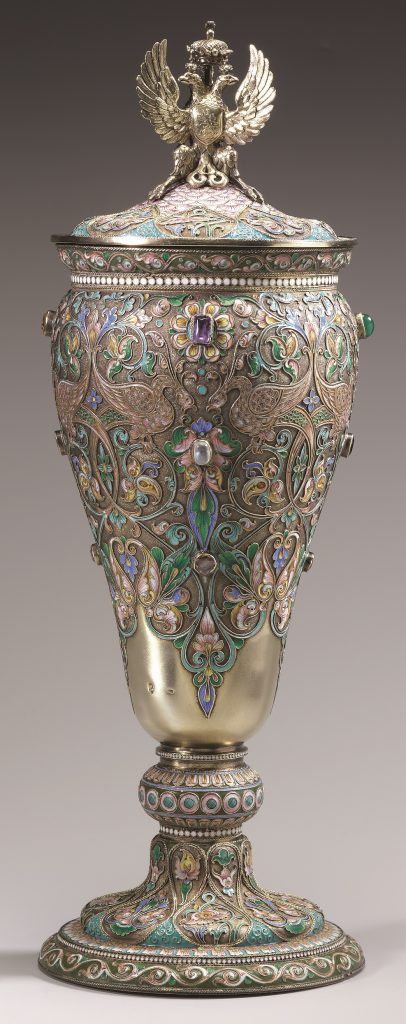



Title: Standing Cup and Cover
Date: 1899-1908
Location: Russia, Moscow
Materials: silver-gilt, opaque and painted filigree enamel, moonstone, green chalcedony and smoky quartz with other semi-precious stones and pastes 88 zolotniks
Dimensions: height 40 cm
Accession Number: RUS 42
Other Notes:
The letter written on Buckingham Palace stationery, addressed to Sir Edward Henry and dated April 4 1907, accompanies this piece: ‘Dear Sir Edward | The Empress | Marie of Russia | desires me to say | that it will give | her much pleasure | if you will accept | the accompanying | souvenir of Her | Majesty’s visit to England | yrs very truly | A. Condie Stephen’.
By the late 19th century, it had become increasingly the practice for members of the Russian imperial family to present to foreign dignitaries pieces of traditional-style enamelwork. The forms chosen, including kovshi, bratiny and covered cups, related to the Boyar past, while the decoration, equally patriotic, derived from the enamels of late 17th-century Moscow and Sol’vychegodsk. In the present example the cast finial in the form of the Romanov double-headed eagle emphasises the imperial provenance. That this surmount was made in St. Petersburg at a slightly earlier date than the Moscow-produced cup and cover indicates that it was made in anticipation of the need to customise shop-purchased wares for imperial presentation.
Sir Edward Richard Henry, 1st Bt (1850-1931), passed a significant part of his career with the Indian Civil Service in Bengal. In the course of his activities there he observed the use on official documents of fingerprints to identify illiterate pensioners and government contractors. Realising the wider uses to which this technique could be applied, Henry, having communicated with other specialists in the field, evolved a simple and reliable method of classification that he published in Classification and Uses of Fingerprints (1900). In 1901 he joined the Metropolitan Police with responsibility for the Criminal Investigation Department. The following year the first conviction by fingerprint evidence was recorded. Between 1903 and 1918 he was Commissioner of Police. Knighted in 1906, he was created a baronet upon his retirement.
Bibliography:
Haydn Williams, Enamels of the World: 1700-2000 The Khalili Collections, London 2009, cat. 13, p. 54.
Zoom
Close

Create your own collection of artworks that you can print or save as a PDF. Please enter you email to enable feature.
Small Flask | JLY 1075
Has been added to your collection.
TIP:
You can now access and view your collection from the main menu at any time.